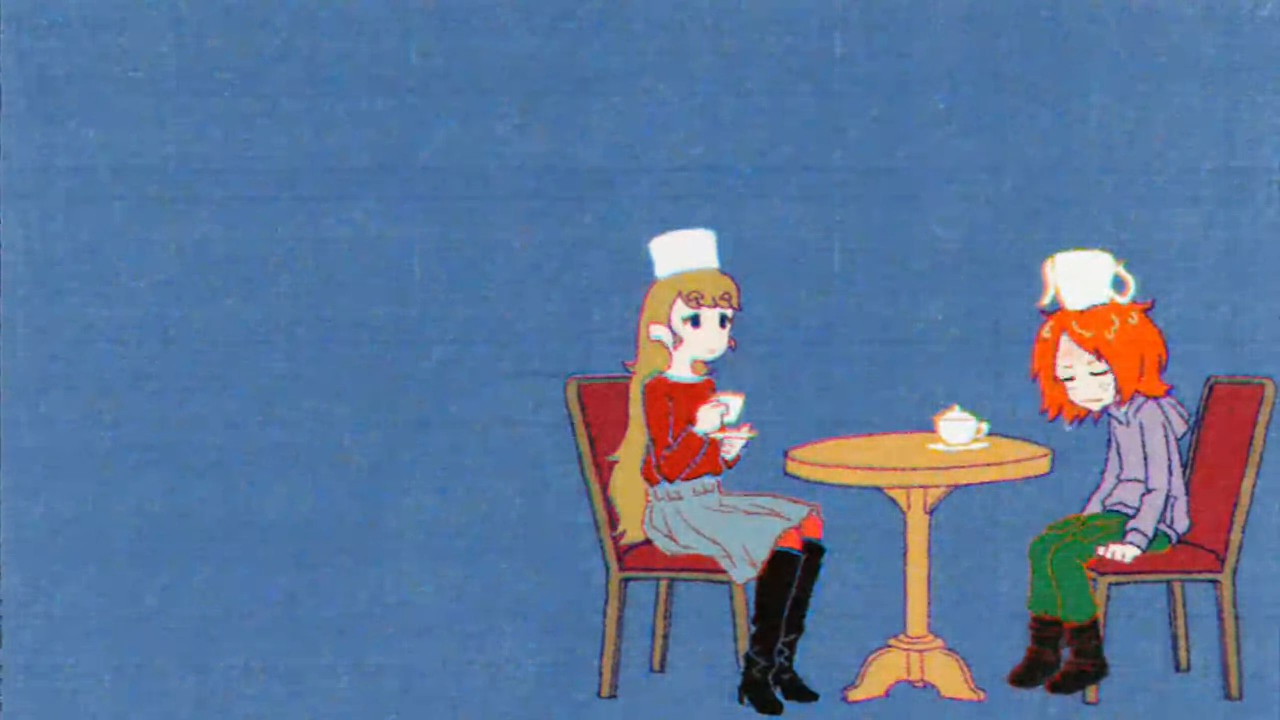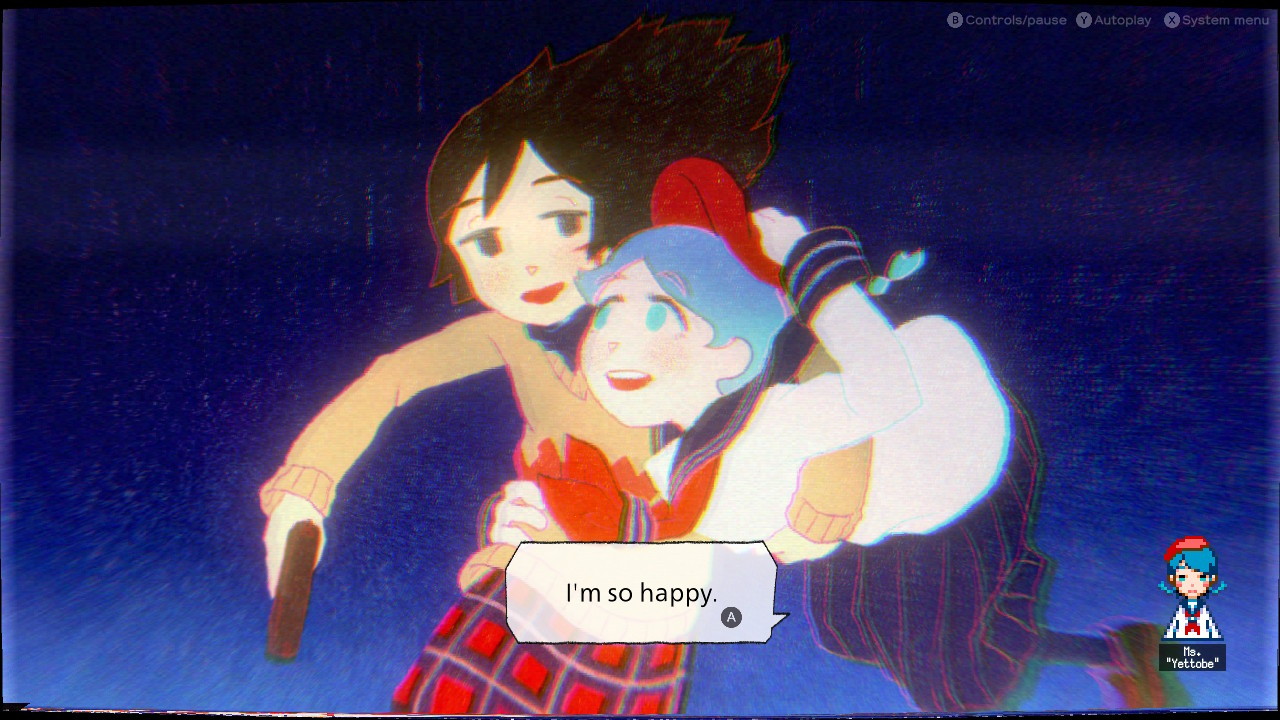ghostpia Season One Review
Nintendo Switch
A dark and myserious visual novel which explores friendship and fitting in.
Reviewed by Elysian on Jun 02, 2023
The first game from Japanese game developer, Chosuido, is a vibrant visual novel with storybook graphics and a screen adorned with glitches. It is a game about finding a sense of self, feeling as though you don’t fit in and rebellion against a society that shuns you.
ghostpia Season One is as much of a game as a TV show or book is. With no distractions to take you away from the story: no quick time events, mini-games or side quests, it is purely a narrative experience for players to read through and enjoy. While this may not seem like the most enticing thing, the art style, story and characters mean that there is never a dull moment. You find yourself truly lost in the world, wondering what will happen next and trying to crack the mysteries of the ghost town alongside Sayoko and her friends.

As the game begins players are introduced to the ghost town the story takes place in - a city with exactly 1024 residents. The world we are placed in has interesting rules. The ghosts can only exist in the darkness of the night, burning and dying if they get caught in the morning sun. If this happens, they find themselves waking up in the garbage dump on the outskirts of town. Everything ends up back there once they are forgotten: belongings, people, and food.
While dying is not permanent for the residents of this ghostly purgatory, it is painful. For this reason, the people there, or ghosts rather, go about their lives at night.
Despite their undying nature, the ghosts do not capitalise on their immortality. Instead, they are stagnant and unchanging, stuck in the same jobs and following the same routine. The local cafe owner admits to working until morning and then going to bed.
Sayoko is one such ghost and the protagonist of ghostpia. Having been isolated for a long time, longer than she can remember, and having very little memory of the events that occurred before the story begins, she is a morally grey character who we quickly learn has a dubious past.
She is referred to as the ninja by everyone around her, jokingly by her friends and out of fear by members of the church and general society. Police are watching her every move, waiting for her to cause trouble and the Priest, a pompous figurehead who acts like a God, has warned people to be wary of her. Despite this, neither the player nor Sayoko herself knows why she has this nickname or what happened in the past to lead to this level of observation.

Chapter One does an excellent job of setting the scene and explaining to the player (or rather, the reader) what this strange world we find ourselves in is. There is no real explanation as to why the town is the way it is, why the ghosts exist the way they do or what is really happening, but it still strangely makes sense.
We are quickly introduced to Sayoko’s two friends: Anya and Pacifica. Having lost touch with them after an incident with a car that none of them can quite remember but they are eventually reunited over unusual happenings in the town - namely the introduction of a new ghost.
One thing that ghostpia does exceptionally well is build unique and morally dubious characters. Anya comes across as stand-offish, Pacifica seems aloof and views everything in a distant way as though it exists for their entertainment. Sayoko resorts to violence quickly, often not thinking through her other options. Despite their flaws, each character has a special place in the story and they fit together exceptionally well. While they feel like they shouldn’t have anything to do with each other based on their backgrounds, they somehow make the perfect team.
The story in ghostpia Season One follows the introduction of a mysterious 1025th ghost into the town. Having had an unchanging number of residents for as long as anyone can remember, their arrival causes quite a stir for both the friend groups and the imposing church that has a hold over a large portion of the town. We follow the group as they come to know one another, share special moments and act in ways that we can’t always rationalise.

In a way, it feels like the player is observing what is going on. With no real power to change the outcome of the story, we are just along for the ride. This can be stressful. Whereas in most visual novels you can somewhat cause the outcome and mistakes made are a result of your own actions and poor decisions.
There are no real controls in ghostpia. Pressing A will move to the next piece of dialogue or text, but you can also opt to have the game autoplay and using the analogue will let you rewind or fast-forward through the story. These controls felt a bit too tedious for me, while it was nice to be able to go back to rewatch pieces of the story that I didn’t feel like I understood fully, the autoplay was way too slow for me and clicking the A button constantly became irritating quickly.
Despite this, you still feel somewhat involved in the story. Perhaps you are a silent member of the group, unacknowledged but still as much a part of the team as anyone else in the story. You have no say in what moves the group makes but, in pressing the button to continue, you are making those moves.
While playing ghostpia, I frequently found myself wondering why it took the form of a game as opposed to a manga, comic or animation. The graphical style, despite being beautiful, doesn’t appear to need to be used in a game format with very little movement and frequent still shots. Mimicking the cartoonish, hand-drawn style of anime and manga, ghostpia is lovely to look at. The graphical style also makes each violent scene feel less imposing and feeds into the idea that death doesn’t matter.

Similarly, the graphical glitches which flickered in the corners of my screen didn’t add much to ghostpia overall. The main role of the glitching, which the game kindly warns you at the start of each chapter about so that you don’t have to worry about having broken your switch, seems to be to create a sense of vintage. Maybe you are watching back a VHS telling the story of the ghost town in a time past or perhaps the undying and yet unliving nature of the world affects electronics.
One element of the game which was especially mesmerising and, most likely the highlight of the whole experience, was the music. Beautifully composed by Hiromu Takano, the music captures the emotion and tension of each scene perfectly. Similarly, the sound effects and dialogue sounds come together to create a really nice soundscape.
ghostpia is a beautiful experience, and an unfinished one with the potential for season two hovering in the distance, but considering the high price and amount of reading necessary, it is not something I can recommend to most people.
For gamers who enjoy reading or art, it may be worth the investment: there is a lot of content, with each of the five chapters being split into two halves and the entire story is intriguing. However, if you do not find yourself able to focus on a book or get easily distracted, ghostpia is likely not for you.
Subscriber, NoobFeed
Verdict
ghostpia is a beautiful experience, and an unfinished one with the potential for season two hovering in the distance, but considering the high price and amount of reading necessary, it is not something I can recommend to most people.
73
Related News
No Data.

